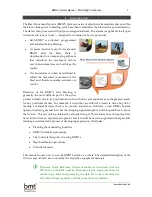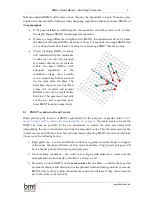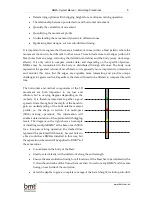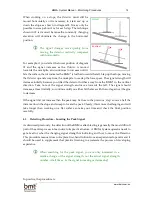
BMM
®
System
Manual
– Monitoring Procedures
15
www.bmt.com.au
a)
Turn on the
Remote Processing Module
(RPM)
by pressing the button on top of the unit.
b)
Turn
on the
Controller
by pressing the
Power
button.
Select the “Blast Name” from the pull down menu.
Select
Detect.
c)
Set the range to a suitable value – usually 8-10.
d)
Select the BMM
®
colour that you are searching for. This information is contained on the
blast plan created during installation.
As a general rule, start a search by walking along a slope, i.e.
approximately constant elevation rather than up or down a slope.
More area can be scanned in a short time because it is slow to
“staircase” up and down a slope. Once the maximum is found along
the slope, you will only have to go up or down once to get close to the
peak.
e)
Find a BMM
®
signal.
o
Before you can pinpoint a BMM
®
, you have to get within range. Therefore, your
initial objective is to just locate a signal.
o
You will not pick up a signal until you are within about 15 - 20 m of the BMM
®
so keep this in mind when planning your search path.
o
To quickly locate the general vicinity of a BMM
®
, walk an approximately straight
line and approximately constant elevation if possible (e.g. along a slope rather
than up it), towards where you think a BMM
®
will be (or was).
o
The signal strength will rise very quickly as you approach the BMM
®
, unless it
is close to the limit of the
Detector.
f)
As you get closer to the signal, it will probably be
necessary to
decrease the range
to maintain the
signal at a level that does not overload the
detector.
g)
BMM
®
Signal located
o
When a signal is detected, keep going
straight in that direction until the signal
decreases.
o
Always
walk 2-3 m
past
this first peak to
be sure it is not the “phantom peak”
(discussed in Section 4.6).
o
Back up to about where the maximum
was. You are now at location
in the
diagram to the right.
3D Surface Plot (Survey Points in Results - Survey Both.stw 4v*98c)
mV = Distance Weighted Least Squares
250
200
150
100
50
0
-50











































